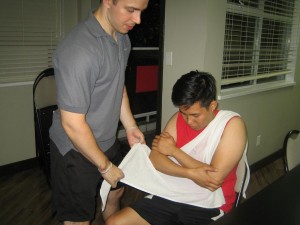An arm sling is a kind of bandage that gives backing to an incapacitated joint. Usually an arm sling is used when a joint is impaired, displaced and damaged caused by a surgical procedure. The purpose of an arm sling is to keep the injured arm or shoulder immovable to allow time for muscles, tendons and bones to heal.
[youtube url=”https://www.youtube.com/watch?v=I9cOMFN4Vso”]A good and effective sling is made from a piece of triangular cotton bandage. These bandages can be found in first aid kits. In case of emergencies, you can make slings from belts or from pieces of clothes. In first aid situations, slings are used to temporarily immobilize the arm and give some relief from discomfort. When using a sling, make sure that there is proper circulation in the supported arm by checking the pulse at the wrist or by squeezing a fingernail to see if there is a colour change in the nail bed.
Types of sling used for arm and shoulder injury

- Standard arm sling – they are used for injuries to the forearm like sprains or fractures. It gives support to the forearm so that it is parallel to the ground and the wrist is higher than the elbow. It is hanged over the shoulder on the uninjured side of the body and tied securely in place.
- Elevated or shoulder sling – these slings are used to help support the injured shoulder. They are created by using a wedge-shaped piece of cloth. The arm is placed over it so the top portion of the triangle is at the elbow and the wrist is resting between the two points, then they are brought up and then tied behind the neck. It limits the movement of the shoulder while healing the injury. An elevated sling differs from a traditional sling because it is supporting the arm above the level of the heart in order to minimize the pain and swelling. It is also good for a broken clavicle or a dislocated shoulder. In an elevated sling, it allows better flow of blood and for a faster repair of the injury.
- Collar-and-cuff sling – used for upper arm injuries or a dislocated collar bone and when there is no standard bandage available. In this kind of sling, the elbow hangs at the side of the body while the injured arm of the hand is placed to the uninjured shoulder. Wrap a belt or a piece of cloth around the wrist of the injured arm and the ends of the cloth or belt are wrapped around the neck and tie. The arm hangs with a collar-and-cuff sling and it cannot be moved. If extra support is required, bandages or wraps can be placed around the body and the upper arm in order to hold the arm firmly at the chest.
